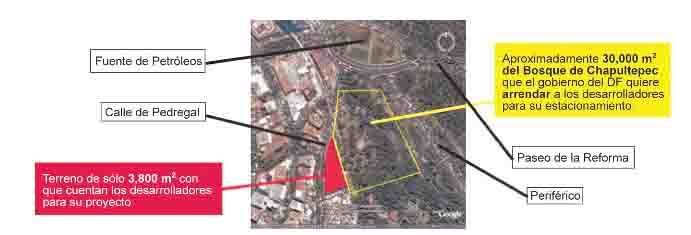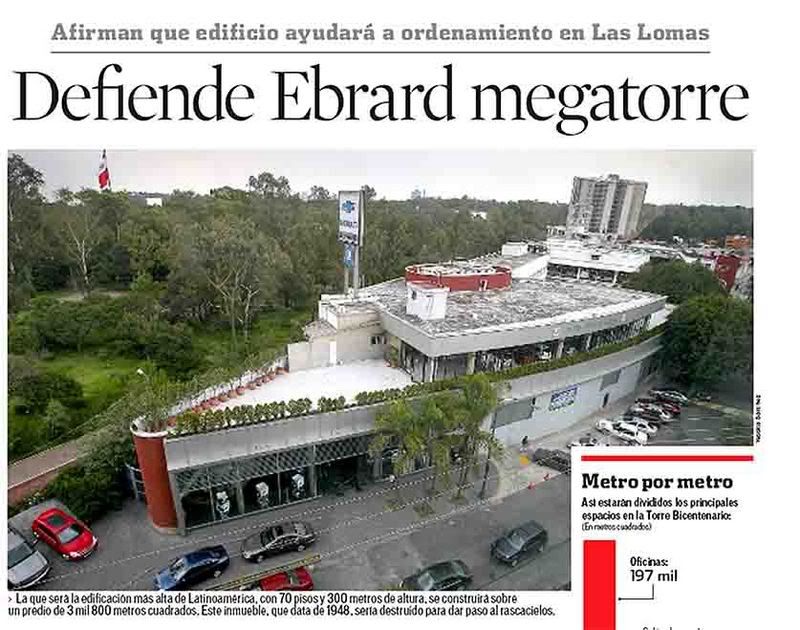Algo que jamás consideró “El mejor alcalde del mundo”, nuestro prócer @M_Ebrard:


Parece que el día 25 de octubre hay un pronunciamiento sobre el juicio en disputa legal entre el INBA y el Grupo Danhos
Si lo pierde el INBA, entonces el Grupo Danhos procederá a demoler la obra arquitectónica de Vladimir Kaspé para iniciar la construcción de [color=#ff006d]la torre.
Y a los ciudadanos, ni en cuenta nos toman...


Parece que el día 25 de octubre hay un pronunciamiento sobre el juicio en disputa legal entre el INBA y el Grupo Danhos
Si lo pierde el INBA, entonces el Grupo Danhos procederá a demoler la obra arquitectónica de Vladimir Kaspé para iniciar la construcción de [color=#ff006d]la torre.
Y a los ciudadanos, ni en cuenta nos toman...
Originalmente publicado por Rafael Norma
Ver post
MEXICO CITY JOURNAL
A Tower Fight, but Just What Borough Is This?
Adriana Zehbrauskas for The New York Times

Plans for the tallest building in Latin America bring protests of “No to the Bicentennial Tower.”
•
E-MAIL
• PRINT
• REPRINTS
• SAVE
• SHARE
By ELISABETH MALKIN
Published: September 20, 2007
MEXICO CITY, Sept. 19 — An influential developer plans an enormous skyscraper at the edge of the city’s giant central park. A celebrity architect is commissioned, and the ambitious mayor unveils the proposal at city hall.
Enlarge This Image
[IMG]http://graphics8.nytimes.com/images/2007/09/20/world/americas/20skyscraper-190.jpg[&IMG]
Office for Metropolitain Architecture
Rem Koolhaas’s design for the skyscraper would join two pyramidal forms with views of Mexico City’s huge central park.
Instantly, the prospective tower’s largely genteel neighbors rise up in arms. They vow to tie the plan up in lawsuits and procedural reviews. There is also a reclusive investor, a much-questioned relationship between the mayor and the developer and a building on the site that, though it has long been ignored, preservationists now want saved.
It could be New York.
But this is Mexico City, and the fight over what would be Latin America’s tallest skyscraper — at 300 meters, or 984 feet — takes on a tinge of high drama.
The developers and their allies in city hall say the tower will catapult Mexico City into the ranks of the world’s great cities, alongside emergent Asian capitals where skyscrapers grow ever taller. For Mexico City to compete globally, “we will need dozens of projects like this,” said Jorge Gamboa de Buen, the chief executive of the project’s developer, Grupo Danhos. “The city will have to learn to deal with the issue of these projects.”
Opponents say the tower is simply illegal. “They are twisting the law around like a pretzel to get their objectives through,” said Denise Dresser, an academic and commentator who is helping organize opponents. She said the city’s support for the tower recalled the days when authoritarian governments built big public works projects whether anybody wanted them or not.
The leftist mayor, Marcelo Ebrard, a likely presidential candidate in 2012, is determined to make his mark on the city.
“No other city in Latin America will have a tower of this size now,” Mr. Ebrard said when he presented the project with Mr. Gamboa de Buen in late July. “We’re ahead of everybody else.”
Mr. Ebrard’s chief political opponent on the project is a 28-year-old conservative, Gabriela Cuevas, the elected official in charge of the delegation (similar to a borough) where the site lies. The project’s supporters argue that she has jumped on the issue to further her career.
“It’s not politics to want to apply the law,” Ms. Cuevas said. “It’s a matter of what Mexico you believe in.”
The legal core of the debate is the site’s zoning, which is now limited to commercial buildings of just five stories. The site cost Danhos just $18 million, far less than if zoned for a high-rise.
The developers need a change in zoning, which is up to the city legislature, dominated by Mr. Ebrard’s party. “They bought the land cheap, and now they want the legislature to modify it just for them,” Ms. Cuevas said.
The 70-story tower would loom over the edge of Chapultepec Forest, the vast park that dates to before the Spanish Conquest. It will be called the Bicentennial Tower — ready, Danhos executives hope, by 2010, when Mexico celebrates 200 years of independence from Spain.

Bypassing Mexico’s own well-known architects, Danhos sought out a global star, the Dutch architect Rem Koolhaas. Alluding to Mexico’s pre-Columbian past, Mr. Koolhaas’s design joins two pyramidal forms. One editorial cartoonist redrew the design as a coffin holding the remains of the city’s urban plan.
Danhos will split the $600 million investment with an investment company owned by the Spanish billionaire Amancio Ortega, the press-shy founder of the Zara clothing chain and the eighth-richest man in the world, according to Forbes.
Although there are skyscrapers nearby, the site is surrounded by a middle-class neighborhood of low-rise houses, offices and stores. Several blocks away, though, lies one of the wealthiest neighborhoods, where high walls shield expansive houses.
The tower would also abut the intersection of two main traffic arteries, one of the city’s worst bottlenecks. With the cars it would bring, opponents argue, the city should find it impossible to approve the environmental and urban impact studies.
If all this sounds like a city with no real plan, it is. Mexico City is pocked with high-rises hulking over residential streets. And 15 years of unchecked development in the western suburbs has created a mini-city of towers, Santa Fe, without proper roads or public transportation leading to it.
Opponents have seized on the mess in Santa Fe to bolster their case against the mayor and Mr. Gamboa de Buen, who worked together as city officials to launch Santa Fe. Mr. Gamboa de Buen blames succeeding mayors for ignoring the area.
The tower would be built according to strict international environmental and earthquake standards, using little water and energy. And Danhos promises underpasses and other improvements to deal with the traffic.
For now the project has been slowed by legal wrangling over the building currently on the site, an example of mid-20th-century functionalist architecture designed by a Russian émigré, Vladimir Kaspé. The National Fine Arts Institute rushed through an upgrade of the building’s protected status last month.
The opposition says it is growing, hiring a well-known environmental lawyer, adding celebrities and enlisting support from people in less privileged areas.
“It’s not like other countries here,” said Mike Rios, a retired teacher who has fought new construction in his working-class neighborhood. “In Japan, when it’s ecological, they can’t touch it. Here, it’s just the opposite.”
A Tower Fight, but Just What Borough Is This?
Adriana Zehbrauskas for The New York Times

Plans for the tallest building in Latin America bring protests of “No to the Bicentennial Tower.”
•
• REPRINTS
• SAVE
• SHARE
By ELISABETH MALKIN
Published: September 20, 2007
MEXICO CITY, Sept. 19 — An influential developer plans an enormous skyscraper at the edge of the city’s giant central park. A celebrity architect is commissioned, and the ambitious mayor unveils the proposal at city hall.
Enlarge This Image
[IMG]http://graphics8.nytimes.com/images/2007/09/20/world/americas/20skyscraper-190.jpg[&IMG]
Office for Metropolitain Architecture
Rem Koolhaas’s design for the skyscraper would join two pyramidal forms with views of Mexico City’s huge central park.
Instantly, the prospective tower’s largely genteel neighbors rise up in arms. They vow to tie the plan up in lawsuits and procedural reviews. There is also a reclusive investor, a much-questioned relationship between the mayor and the developer and a building on the site that, though it has long been ignored, preservationists now want saved.
It could be New York.
But this is Mexico City, and the fight over what would be Latin America’s tallest skyscraper — at 300 meters, or 984 feet — takes on a tinge of high drama.
The developers and their allies in city hall say the tower will catapult Mexico City into the ranks of the world’s great cities, alongside emergent Asian capitals where skyscrapers grow ever taller. For Mexico City to compete globally, “we will need dozens of projects like this,” said Jorge Gamboa de Buen, the chief executive of the project’s developer, Grupo Danhos. “The city will have to learn to deal with the issue of these projects.”
Opponents say the tower is simply illegal. “They are twisting the law around like a pretzel to get their objectives through,” said Denise Dresser, an academic and commentator who is helping organize opponents. She said the city’s support for the tower recalled the days when authoritarian governments built big public works projects whether anybody wanted them or not.
The leftist mayor, Marcelo Ebrard, a likely presidential candidate in 2012, is determined to make his mark on the city.
“No other city in Latin America will have a tower of this size now,” Mr. Ebrard said when he presented the project with Mr. Gamboa de Buen in late July. “We’re ahead of everybody else.”
Mr. Ebrard’s chief political opponent on the project is a 28-year-old conservative, Gabriela Cuevas, the elected official in charge of the delegation (similar to a borough) where the site lies. The project’s supporters argue that she has jumped on the issue to further her career.
“It’s not politics to want to apply the law,” Ms. Cuevas said. “It’s a matter of what Mexico you believe in.”
The legal core of the debate is the site’s zoning, which is now limited to commercial buildings of just five stories. The site cost Danhos just $18 million, far less than if zoned for a high-rise.
The developers need a change in zoning, which is up to the city legislature, dominated by Mr. Ebrard’s party. “They bought the land cheap, and now they want the legislature to modify it just for them,” Ms. Cuevas said.
The 70-story tower would loom over the edge of Chapultepec Forest, the vast park that dates to before the Spanish Conquest. It will be called the Bicentennial Tower — ready, Danhos executives hope, by 2010, when Mexico celebrates 200 years of independence from Spain.

Bypassing Mexico’s own well-known architects, Danhos sought out a global star, the Dutch architect Rem Koolhaas. Alluding to Mexico’s pre-Columbian past, Mr. Koolhaas’s design joins two pyramidal forms. One editorial cartoonist redrew the design as a coffin holding the remains of the city’s urban plan.
Danhos will split the $600 million investment with an investment company owned by the Spanish billionaire Amancio Ortega, the press-shy founder of the Zara clothing chain and the eighth-richest man in the world, according to Forbes.
Although there are skyscrapers nearby, the site is surrounded by a middle-class neighborhood of low-rise houses, offices and stores. Several blocks away, though, lies one of the wealthiest neighborhoods, where high walls shield expansive houses.
The tower would also abut the intersection of two main traffic arteries, one of the city’s worst bottlenecks. With the cars it would bring, opponents argue, the city should find it impossible to approve the environmental and urban impact studies.
If all this sounds like a city with no real plan, it is. Mexico City is pocked with high-rises hulking over residential streets. And 15 years of unchecked development in the western suburbs has created a mini-city of towers, Santa Fe, without proper roads or public transportation leading to it.
Opponents have seized on the mess in Santa Fe to bolster their case against the mayor and Mr. Gamboa de Buen, who worked together as city officials to launch Santa Fe. Mr. Gamboa de Buen blames succeeding mayors for ignoring the area.
The tower would be built according to strict international environmental and earthquake standards, using little water and energy. And Danhos promises underpasses and other improvements to deal with the traffic.
For now the project has been slowed by legal wrangling over the building currently on the site, an example of mid-20th-century functionalist architecture designed by a Russian émigré, Vladimir Kaspé. The National Fine Arts Institute rushed through an upgrade of the building’s protected status last month.
The opposition says it is growing, hiring a well-known environmental lawyer, adding celebrities and enlisting support from people in less privileged areas.
“It’s not like other countries here,” said Mike Rios, a retired teacher who has fought new construction in his working-class neighborhood. “In Japan, when it’s ecological, they can’t touch it. Here, it’s just the opposite.”

 no es
no es



 hotomx@prodigy.net.mx]
hotomx@prodigy.net.mx]  : Gamboa de Buen hayan otorgado licencias de con$trucción y cambio$ de u$o del $uelo a los e$peculadore$ que destruyeron nuestro habitat, al con$truir Edifi$ios $in Esta$ionamiento entre Palmas, periférico y el Paseo de la Reforma
: Gamboa de Buen hayan otorgado licencias de con$trucción y cambio$ de u$o del $uelo a los e$peculadore$ que destruyeron nuestro habitat, al con$truir Edifi$ios $in Esta$ionamiento entre Palmas, periférico y el Paseo de la Reforma :trmnt:
:trmnt:
Comment